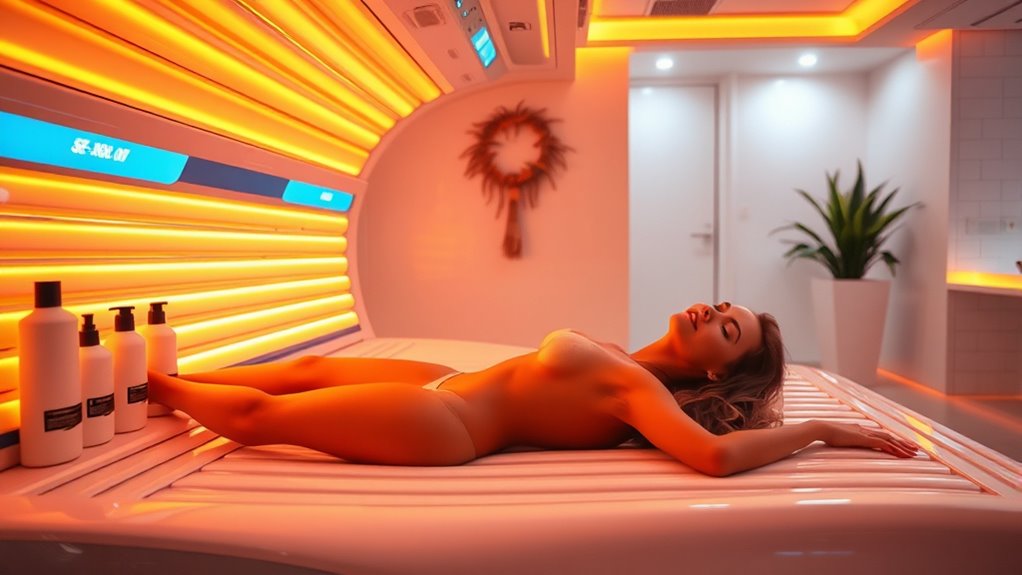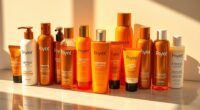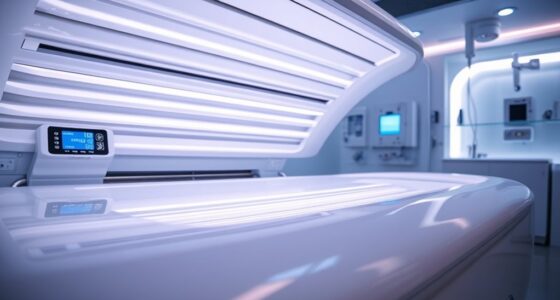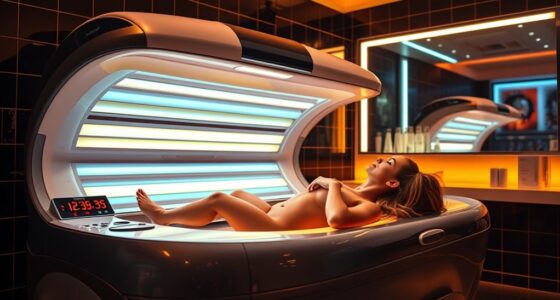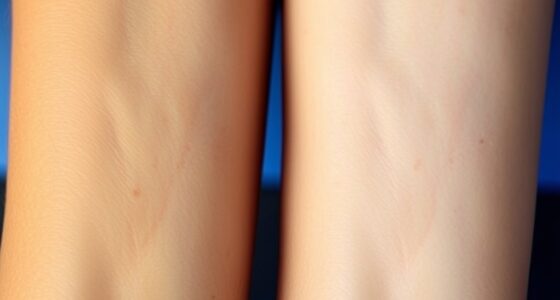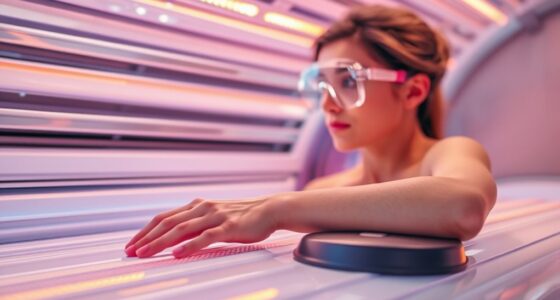To use tanning beds safely, always protect your eyes with UV-blocking goggles designed for tanning, and follow the manufacturer’s guidelines on session duration and equipment use. Limit your sessions to avoid overexposure, taking at least 48 hours between visits, and adjust based on your skin type. Avoid tanning if your skin is irritated or damaged, and consider alternatives like spray tans for safer results. Keep informed about skin health to minimize risks—there’s more to guarantee your safety.
Key Takeaways
- Always wear UV-blocking goggles designed for tanning, ensuring full coverage and proper fit before each session.
- Start with short sessions (3-8 minutes) and space them at least 24-48 hours apart to prevent skin damage.
- Follow manufacturer guidelines for equipment use, including proper positioning, exposure times, and regular maintenance checks.
- Avoid tanning if your skin is irritated, damaged, or inflamed, and monitor skin response to prevent burns and premature aging.
- Consider UV-free alternatives like spray tanning for safer, risk-free bronzing and skin health preservation.
Prioritize Eye Safety With Proper Protection

To safeguard your eyes during tanning bed sessions, it’s essential to use UV-blocking protective goggles that are specifically designed for this purpose. Make sure your goggles block at least 99% of UVA and UVB rays, providing full coverage and a snug fit to prevent UV penetration. Never substitute regular sunglasses or non-specialized eyewear—they simply don’t offer the right protection. Always keep a spare pair handy in case one gets lost or damaged. Before each session, guarantee your goggles are clean and intact to maintain maximum UV blocking. Proper eye protection minimizes the risk of eye damage, such as cataracts or photokeratitis. Incorporating proper fit and coverage during preparation ensures optimal safety practices. Additionally, choosing goggles that are certified for tanning beds can further enhance your eye safety. Ensuring your goggles are specifically designed for UV protection is crucial for effective shielding, which helps keep your eyes safe while enjoying tanning bed sessions.
Follow Manufacturer’s Usage Guidelines Strictly
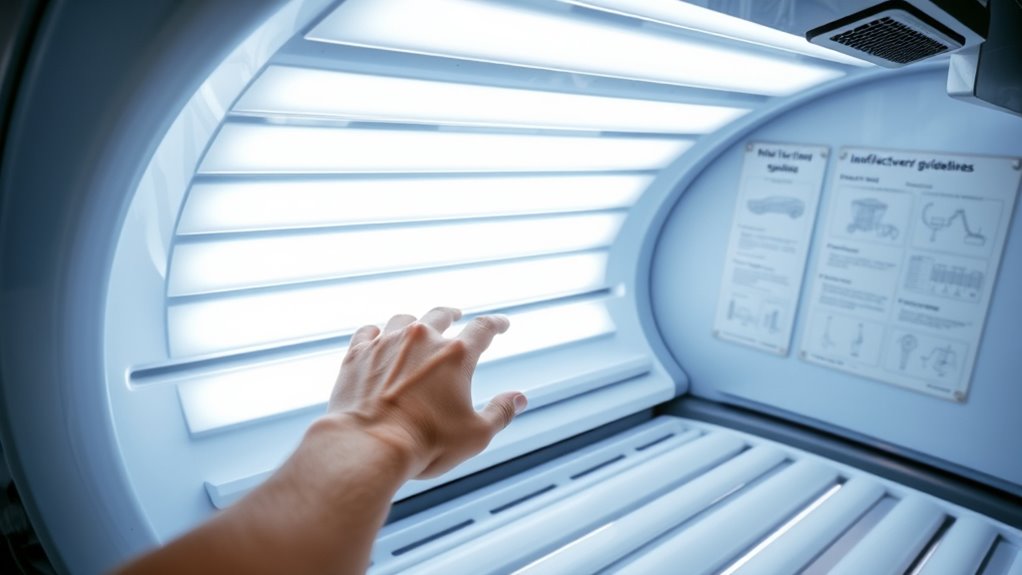
Following the manufacturer’s usage guidelines is essential for safe and effective tanning bed sessions. You should strictly adhere to recommended exposure times and levels to prevent overexposure and skin damage. Make sure you’re properly positioned inside the bed to ensure even UV distribution and maximize results. Pay attention to warnings about skin sensitivities, medications, or medical conditions that could make tanning unsafe. Use only approved skin products compatible with UV exposure, and follow manufacturer instructions carefully. Before starting, operators must thoroughly brief you on correct usage based on the guidelines. Always ensure the tanning bed’s safety features, like timers and shields, are functioning properly. Proper compliance helps protect your health and ensures a consistent, safe tanning experience. Additionally, understanding the importance of natural materials used in Waldorf toys can serve as a reminder to choose quality and safe products for your children. Being aware of industry standards can further ensure that equipment is maintained and operated safely. Regularly reviewing manufacturer updates and safety recommendations can help keep your tanning sessions both enjoyable and risk-free. It is also advisable to periodically check the filter and bulb conditions to maintain optimal UV output and safety levels.
Limit Session Duration and Frequency
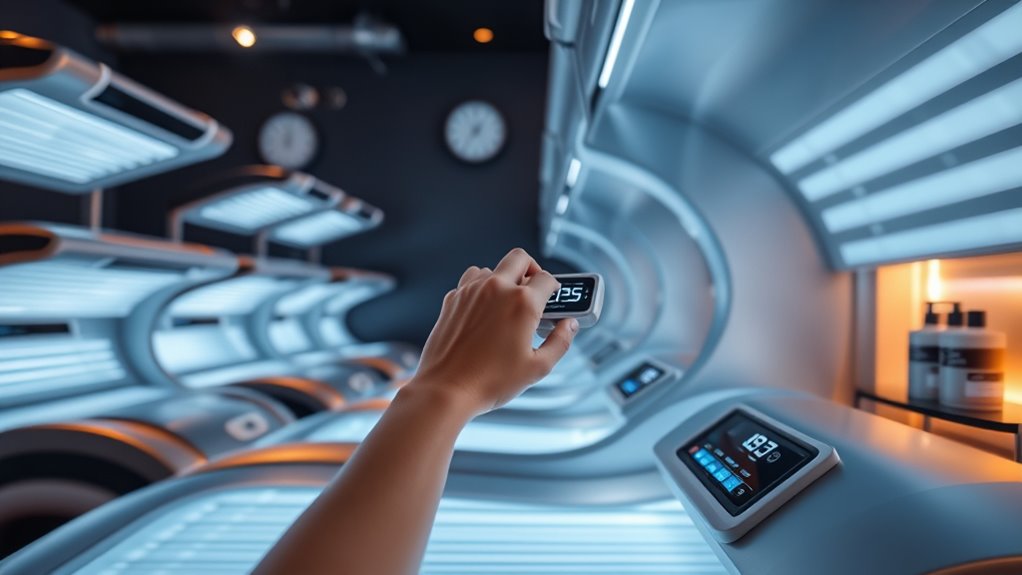
Limiting your tanning bed sessions in both duration and frequency is essential for safe and healthy tanning. Start with short sessions—about 3-8 minutes—especially if you have sensitive skin, and gradually increase if no irritation occurs. Never exceed the maximum time recommended for your skin type; for example, Type 1 skin should stay within 5-8 minutes, while Type 3 can handle up to 12-15 minutes. Keep sessions 48 hours apart to allow your skin to recover, and begin with 2-3 sessions weekly. As your skin adapts, you can increase to 3-4 times per week, then reduce to once or twice for maintenance. Always monitor your skin’s response and adjust accordingly to minimize risks like burns and irritation. Incorporating skin preparation steps such as exfoliation and moisturizing can further promote an even tan and healthier skin. Understanding skin sensitivity can help you better tailor your tanning routine to minimize adverse effects. Staying informed about machine learning advancements can help you better understand and optimize your tanning routines through emerging technologies, including headphone compatibility with various devices for a more enjoyable experience.
Avoid Tanning if Skin Is Irritated or Damaged

If your skin is irritated or damaged, tanning beds should be avoided because UV exposure can worsen the condition. Tanning can cause rashes, white spots, and heat rash by irritating sensitive skin. It can also increase discomfort if your skin is already inflamed or tender. Chemical sensitivities from lotions or cleaners used in tanning salons may lead to further irritation or even skin infections from unclean beds. Certain medications heighten your skin’s sensitivity to UV rays, making tanning more risky. Damaged skin is more prone to burning, discoloration, and premature aging. Additionally, UV exposure can escalate itchiness, inflammation, or cause fever if an infection develops. To protect your skin’s health, wait until irritation subsides before considering any tanning methods. Increased smartphone usage among seniors highlights the importance of gentle skincare and monitoring for adverse reactions. Being aware of Bitcoin IRA strategies can help you navigate your investment options safely during periods of skin vulnerability.
Use Sunscreen on Unexposed Skin Areas
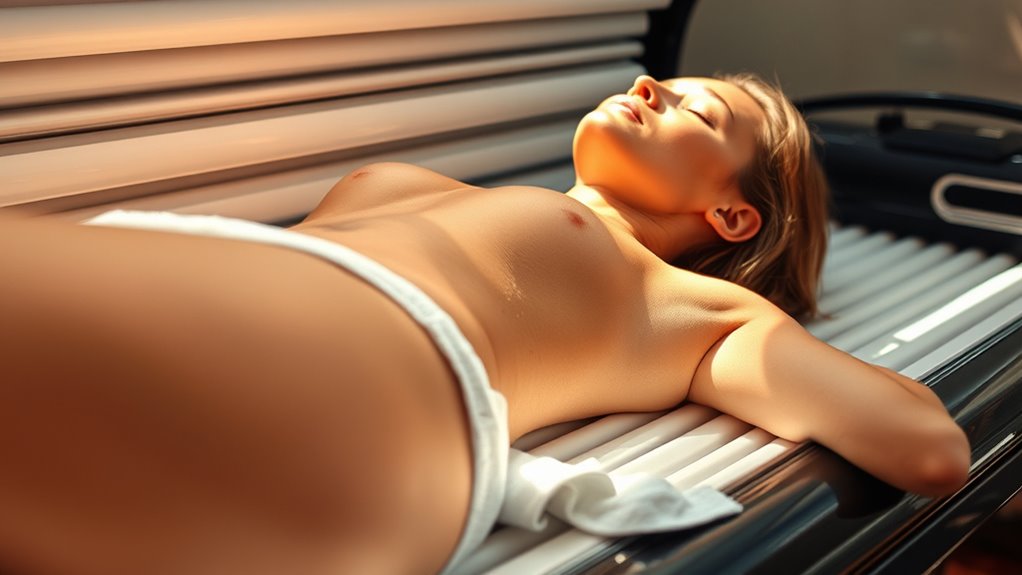
While tanning beds primarily target exposed skin, applying sunscreen on unexposed areas is an important step to protect your skin from UV damage. Although sunscreen isn’t necessary inside tanning beds due to regulated exposure, it’s essential for skin you want to keep safe from UV rays. Apply broad-spectrum sunscreen with SPF 30 or higher to all areas not directly exposed, like your face, neck, and hands. This helps prevent UV-related damage, burns, and photoaging on those patches. Wait for the sunscreen to fully absorb before tanning to avoid interference with the process. Reapply if you’re exposed to sunlight afterward. Remember, sunscreen on unexposed skin doesn’t block tanning completely but does reduce long-term damage risks, supporting healthier skin overall. Additionally, low light office plants can improve your environment and promote a healthier, more relaxing space around you. Proper skin protection strategies are crucial to maintaining skin health during tanning sessions. Incorporating UV safety measures can further enhance your skin care routine and minimize risks, especially considering the importance of understanding the Hackathons and best practices for software quality assurance in related fields.
Maintain Equipment in Good Condition

Maintaining your tanning equipment in good condition is essential for safe and effective sessions. Regularly clean acrylic shields with approved disinfectants after each use to prevent oil, sweat, and bacteria buildup. Wipe down exterior surfaces daily to keep the unit hygienic. Polish reflectors and wipe lamps every 250 hours to maximize UV output. Conduct routine inspections by turning the bed on, checking lamps for flickering, and listening for unusual noises. Deep clean acrylic shields weekly and look for cracks or damage. Keep ventilation fans free of dust and debris to prevent overheating. Replace worn or damaged lamps and acrylic shields immediately to ensure safety and tanning quality. Additionally, performing preventive maintenance can help identify potential issues early and extend the lifespan of your equipment. Regular equipment inspections also contribute to maintaining optimal performance and safety standards. Document maintenance activities and schedule professional servicing regularly to uphold performance standards. Staying informed about equipment maintenance tips can help prevent costly repairs and ensure optimal tanning results.
Adjust Settings According to Skin Type
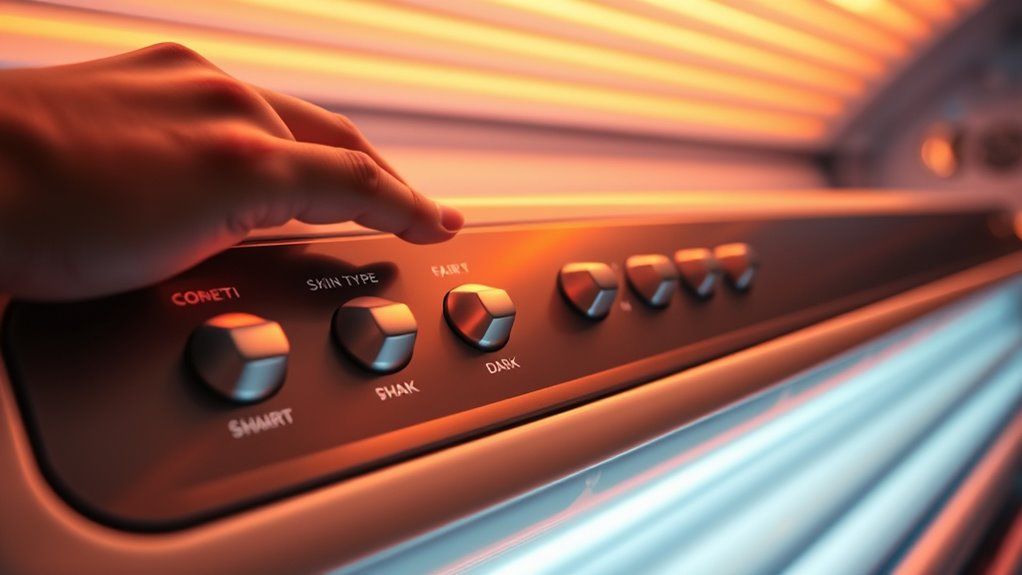
Adjusting your tanning bed settings based on your skin type is essential for safe and effective results. First, identify your skin type—pale, fair, medium, or dark—to determine the appropriate exposure. Pale and fair skin types burn easily and should have very limited sessions or avoid tanning beds altogether. Medium skin types tan more easily but still need shorter, controlled sessions, starting at half the recommended exposure. Darker skin tones tolerate longer sessions and higher UV intensity, but caution remains important. Always start with reduced exposure times, especially during initial sessions, and gradually increase as your skin adapts. Use lower UV intensities for lighter skin and moderate settings for medium tones. Consulting a tanning expert can help you select the safest settings tailored to your skin type. Additionally, understanding your AI safety measures can help ensure you’re making informed decisions about tanning practices and safety protocols. Incorporating proper testing procedures can further optimize your safety and results.
Schedule Rest Periods Between Sessions

Scheduling rest periods between tanning sessions is essential to protect your skin from damage and guarantee a safe tanning process. The FDA recommends waiting at least 24 hours between sessions, with 48 hours being the minimum to prevent skin harm, and 72 hours ideal for proper recovery. Your skin needs over a day to activate melanin and renew cells, meaning immediate color post-session isn’t fully developed. For beginners, 2-3 weekly sessions help build a base tan, while maintenance requires just 1-2 weekly. Overexposure risks increase if you schedule more than three sessions weekly or skip rest days. Pay attention to your skin’s response—redness or peeling signals the need for longer breaks. Following these guidelines ensures you tan safely without jeopardizing your skin’s health. Proper rest period management can help you avoid damaging your skin and maximize your tanning results.
Explore Safer Alternatives Like Spray Tans
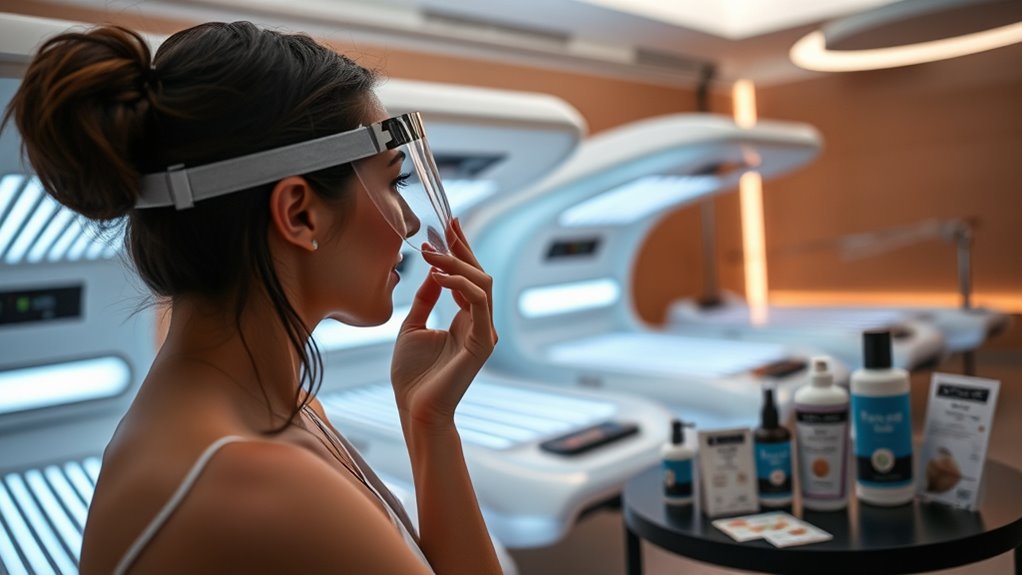
If you’re looking for a safer way to achieve a bronzed look, spray tans offer a convenient and effective alternative to UV tanning methods. Endorsed by major health organizations like the Skin Cancer Foundation and the American Academy of Dermatology, spray tans use dihydroxyacetone (DHA), approved by the FDA, to create a temporary tan without exposing you to harmful UV radiation. DHA reacts only with the outermost skin cells, producing a color that lasts about 5 to 10 days and fades naturally as your skin sheds. They eliminate risks like skin cancer, premature aging, and burns associated with tanning beds. While inhalation risks exist, proper ventilation and protective measures can mitigate these. Overall, spray tans provide a customizable, quick, and safe way to enjoy a bronzed appearance.
Stay Informed and Monitor Skin Health

Staying informed about the risks associated with tanning beds empowers you to make safer choices for your skin health. Tanning beds increase the likelihood of skin cancers like basal cell carcinoma, squamous cell carcinoma, and melanoma, especially if used before age 35. These devices emit UVA and UVB rays, which damage DNA and accelerate skin aging. Regular skin checks help catch early signs of cancer—look for new or changing moles or spots. Schedule routine screenings with healthcare professionals, especially if you frequently use tanning beds. Protect your skin even when not tanning by wearing sunscreen and protective clothing. Staying aware of these risks and monitoring your skin enables you to take control of your health and reduce long-term damage.
Frequently Asked Questions
Can I Use Tanning Beds if I Have Sensitive or Allergy-Prone Skin?
You should avoid using tanning beds if you have sensitive or allergy-prone skin. UV exposure increases your risk of burns, redness, and allergic reactions, and it can worsen existing skin issues. Tanning beds also suppress your immune response, raising your chance of infections. Instead, opt for safer alternatives like sunless tanning products and always protect your skin with broad-spectrum sunscreen to prevent damage.
Are There Specific Signs Indicating I Should Stop Tanning Immediately?
If you notice signs like severe redness, blistering, intense pain, nausea, fever, or swelling while tanning, you should stop immediately. These symptoms indicate serious skin damage or sunburn that can increase your health risks. Don’t ignore persistent itching or discomfort, as they also signal skin injury. Listening to your body and ceasing tanning at the first signs of distress helps protect your skin from long-term damage.
How Do I Know if My Tanning Bed Is Properly Maintained and Safe?
You can tell if your tanning bed is properly maintained and safe by regularly inspecting key components. Check that lamps are replaced every 500-1000 hours, acrylic shields are clean and undamaged, and all mechanical parts are secure. Listen for unusual noises, monitor electrical systems, and make certain ventilation is clear. Follow a routine cleaning checklist and keep detailed maintenance records—these steps help guarantee safe, effective tanning sessions.
What Are the Long-Term Skin Health Effects of Frequent Tanning Bed Use?
Think of your skin as a fragile garden, and frequent tanning bed use as harsh weather. It accelerates aging, causing wrinkles, dark spots, and loss of elasticity. Over time, UV damage increases your risk of skin cancers like basal cell, squamous cell, and melanoma. This damage may not show immediately but can lead to serious health issues years later. Protect your skin now to preserve its health and resilience.
Is It Safe to Tan During Pregnancy or While Taking Certain Medications?
You might wonder if tanning during pregnancy or while on certain medications is safe. While there’s no conclusive evidence that tanning beds directly harm your baby, risks like overheating, burns, and skin pigmentation changes are real. Pregnancy makes your skin more sensitive, and some medications increase photosensitivity, raising burn risks. To stay safe, avoid tanning beds altogether, especially during pregnancy or when taking photosensitive drugs, and consider safer alternatives like self-tanners.
Conclusion
By prioritizing your eye safety, following guidelines strictly, and limiting your sessions, you protect your skin and your health. Avoid tanning when your skin is irritated, use sunscreen on unexposed areas, and adjust settings to suit your skin type. Schedule rest periods, explore safer alternatives, and stay informed to monitor your skin’s health. By practicing these best practices, you guarantee a safer, healthier tanning experience—because your well-being should always come first.
